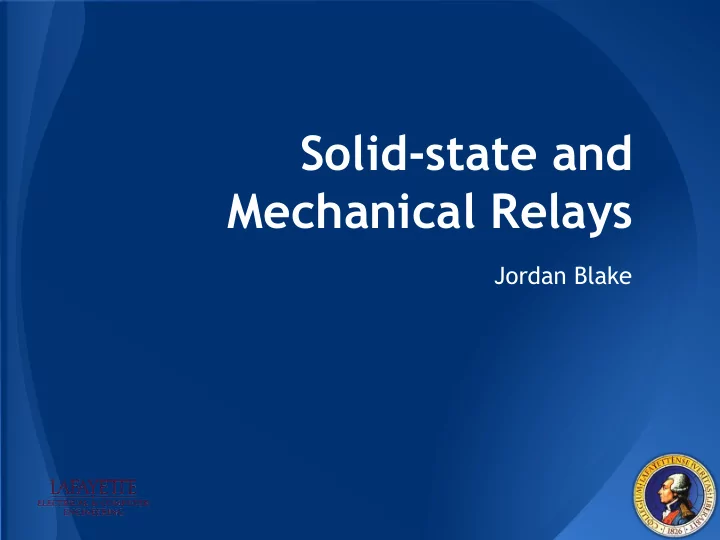

Solid-state and Mechanical Relays Jordan Blake
Overview ● Basic Function ● Types of Relays ○ Mechanical ○ Solid state ● Design Considerations ● Reading the Datasheet ● Common Uses
Basic Function ● Electrically controlled switch ● Control side and Switched side [2] ● Can have many different arrangements
Form Factors Different methods for different applications http://www.gigavac.com/apps/schematics.html
Mechanical Relays [2] ● Reed Type ● Latching ● Time-Delay http://wiki.pickeringtest.net/file/view/Reed_Relay_Diagram. jpg/211412130/420x261/Reed_Relay_Diagram.jpg ● Contactor http://upload.wikimedia.org/wikipedia/commons/6/60/ Latching_relay_bistable_permanent_magnet.jpg
Solid State Relays [3] ● Opto-isolators ● No moving parts ● High usage life ● Limited to lower power ratings ● Transistor voltage drop Lite-On Technology Corp., “Photocoupler,” LTV- 357T datasheet, p.2, May 2014. [Online]. Available: http://optoelectronics.liteon.com/ upload/download/DS70-2001-012/S_110_LTV- 357T%2020140520.pdf. [Accessed: Apr. 28, 2015].
Design Considerations [4] ● Flyback diodes ● Prevents high current when switching inductive loads (relay coil) http://upload.wikimedia.org/wikipedia/commons/thumb/9/ 92/Flyback_Diode.svg/2000px-Flyback_Diode.svg.png ● V = L(di/dt) ● May add hold-up time [1]
Contact Considerations ● Specs should be fitted closely to application ● Too much arcing can damage relay http://upload.wikimedia.org/wikipedia/commons/6/6c/Contacts_-_new_and_used.jpg contacts [1] ● Sometimes an arc is necessary to maintain functionality [1]
Contact Wear Prevention ● Contact Plating/Alloys Silver, Gold-Flashed Silver, Gold Overlay, Silver Nickel, Silver ○ Cadmium Oxide, Silver Tin Indium Oxide, Silver Copper Nickel, Gold Silver Nickel Alloy, Palladium, Tungsten [1] ● Mercury Wetting [1] ● RC circuit/diode ○ For inductive loads that may draw high current [1] ● Blowout Magnet Repels arc and shortens arc time [1] ○
Blowout Magnet Function http://library.automationdirect.com/wp-content/uploads/2013/07/Figure-3-magnetic-arc-suppression.jpg
Choosing the Right Relay ● TSV charger: 30 VDC x 25 A = 750 W ● Charge Relay Contact Rating: 28 VDC x 30 A = 840 W ● Pack Rating: 22.4 VDC x 650 A = 14,560 W ● AIR Rating: http://sigma.octopart.com/37524268/image/Omron- MGN1C-DC24.jpg 800 VDC x 350 A = 280,000 W http://www.evsource.com/images/elec_components/rel ays/Gigavac/gx11.jpg
Choosing the Right Relay ● Not as simple as Load Limit Curve P=I*R ● Usually rated at tangent of curve Tyco Electronics, “Cradle relay N,” V23154 datasheet, p. 7, Aug. 2004. [Online]. Available: http://www.farnell. com/datasheets/50789.pdf. [Accessed: Apr. 28, 2015].
Reading the Datasheet http://www.mouser.com/ds/2/307/MGN_0911-310306.pdf
Common Uses ● Switching large loads with a low-power control circuit ● Galvanic Isolation ● Coaxial Switching ● Control multiple switches with one signal
Galvanic Isolation TSV BoB Schematic, William Stathis http://media.digikey.com/Photos/Omron% 20Elect%20Photos/G5T%20SERIES.JPG
Reference List [1] Tyco Electronics, “Relay contact life,” application note 13C3236, Dec. 2000. [Online]. Available: http://www.te.com/commerce/DocumentDelivery/DDEController?Action=srchrtrv&DocNm=13C3236_AppNote& DocType=CS&DocLang=EN. [Accessed Apr. 28, 2015]. [2] K. G. Oliver, Basic Industrial Electricity: A Training and Maintenance Manual , pp. 258-261, CT: Industrial Press, 1991. [E-book] Available: Google Books. [3] S. Juds, Photoelectric Sensors and Controls: Selection and Application , first ed., pp. 169-171, London: CRC Press, 1988. [E-book] Available: Google Books. [4] M. Jouaneh, Fundamentals of Mechatronics , SI ed., pp. 37-38, MA: Cengage Learning, 2012. [E-book] Available: Google Books.
Recommend
More recommend